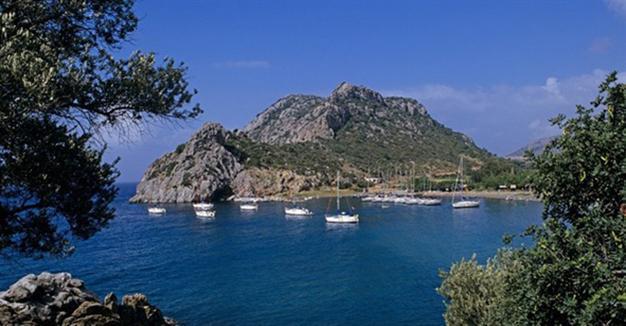Datça, a peninsula between the Aegean and the Mediterranean…
Melih Uslu
 Datça, with the Aegean Sea on one side and the Mediterranean on the other, is a true summer dream with its quiet coves which reflect all shades of green, streets that inspired poets, stone houses wrapped in bougainvillea and the ancient city of Knidos. Various events will be held on Aug. 12 for anniversary of the death of poet Can Yücel, who described Datça as “a wonderful place.” Another nice surprise is waiting those who want to go to Datça, because it is the perfect time for the almond harvest.
Datça, with the Aegean Sea on one side and the Mediterranean on the other, is a true summer dream with its quiet coves which reflect all shades of green, streets that inspired poets, stone houses wrapped in bougainvillea and the ancient city of Knidos. Various events will be held on Aug. 12 for anniversary of the death of poet Can Yücel, who described Datça as “a wonderful place.” Another nice surprise is waiting those who want to go to Datça, because it is the perfect time for the almond harvest.I understood that a rumor saying the roads on the way to Datça were corrupted was not true during my one-hour journey. On the contrary, I enjoyed seeing slopes covered with pine forests, a magnificent sparkling sea appearing at every turn, sailboats gliding on the water and sheltered bays on my way from Dalaman Airport to Datça.
One of the most important privileges of being in Datça is that you can swim almost anywhere while being alone with nature, which was something that I missed.
Bays like Bencik, Çatı and Çiftlik, which are among the best in the Aegean, lay in front of me when I was yet arriving to Datça’s center. I could have stayed in one of the tents and caravans on the way, but I preferred to be close to Datça’s center. I knew I should wait to go to the end of the peninsula to reach the splendid bays and beaches of Datça.
I traveled only three kilometers to arrive in Datça town center. You should definitely go to see the place where famous poet Yücel spent the last years of his life. Old Datça is reminiscent of a charming Mediterranean village with a cute, tiny square. Small box-type houses are made of honey-colored stones.
Almond and olive trees and bougainvillea hang over the whitewashed garden walls. Its art galleries, cafes and boutique hotels are the work of artistic people who came to settle in Datça from large cities.
Müberra Poyrazoğlu, a successful finance specialist in Istanbul who left her profession to settle in Datça, has transformed a centuries-old stone building into a crafts workshop. Another Datça lover is Yaşar Aydoğan, who makes great efforts to revive the fading tradition of silk weaving in the region. Datça was a major silk center in ancient times and Aydoğan continues the traditional production under the name Caria Silk. He also gives sericulture courses to women from nearby villages.
But let us come to Old Datça’s most famous figure, Yücel. The famous poet’s house is surrounded by almond trees on a beautiful narrow street, which was named Can Yücel Street. The poet is commemorated by the Can Festival every year on Aug.12, the date of his death. Our last stop in Old Datça was Orhan’s place in the center of the village, where Yücel loved to spend time when he was in good health. When I took a break in the village coffee shop, the owner of the shop asked, “Would you like having mint, thyme, sage, lavender or watermelon tea?”
This time I headed for New Datça and a few kilometers further saw historic windmills at the entrance of Kızılan Village. I decided to enter the mills. It was an unusual experience for me to see one of the six mills waiting for Don Quixote for about 300 years. In a few minutes you reach the town center as you continue on the main road. Datça’s center, with over 20,000 inhabitants, is so small. It is not difficult to come across shops selling honey, fish and almonds in Datça, which is famous for these three. I was very lucky because I was in Datça at the perfect time for almonds. Fresh almonds were already there. According to experienced manufacturers, the best type of almond is called “Nurlu Baba.” I found myself at the pier enjoying the delicious taste of almonds. Datça Harbor is among the places you love at first sight with its tiny bay lined with blue boats. The island with its palms, connected to the port through a thin way, has an amphitheater where cultural events are performed. You feel like Ilıca Lake is united with the sea when you look at it from far away. There are many fish and seafood restaurants around the harbor. When I asked restaurant managers for advice about fish, they said it was the perfect time to eat leer and they also recommended sea grouper, lobster and porgy.
The road to Knidos is full of views of uninhabited islands. After the Mesüdiye turnoff, I arrived in the most beautiful bays of Datça such as Hayıtbükü and Palamutbükü. Afterwards, green and blue bays lined up in front of me. As the spectacular views went by from the window of my car, I glanced at Nihat Akkaraca’s local guide book called “Datça’da Zaman” (Time in Datça).
As I learned from my reading, there are 52 small bays, which they call “bük.” My journey continues towards the end of the Datça Peninsula. After Yazıköy, I came across with the ancient city of Knidos. It took me on a journey into the past while paving its lush nature in front of me. Knidos, established about 2,500 years ago, was the homeland of many scholars like Sostratos, who built one of the Seven Wonders of the World, the Lighthouse of Alexandria, and mathematician Eudoksos. These lands have hosted so many cultures and civilizations like the Karians, Mykians, Dorians, Persians, Romans, Byzantines and Ottomans. Lastly, I watched the magnificent glow of the sunset as I saluted the lighthouse on the hill.
















